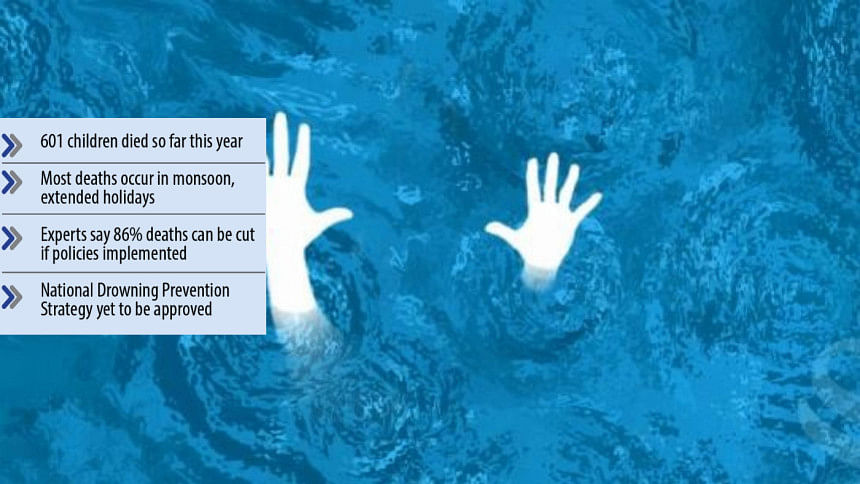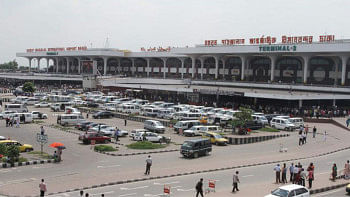World drowning prevention day: Most child drownings go unnoticed

Largely unnoticed and mostly underreported, drowning remains one of the leading causes of death among children in Bangladesh, claiming thousands of young lives every year.
According to government data, drowning is the second leading cause of death among children under five in the country.
Today, July 25, is the World Drowning Prevention Day, a global advocacy event held annually, which serves as an opportunity to highlight the tragic and profound impact of drowning on families and communities and offer lifesaving solutions to prevent it.
The Foundation for Disaster Forum, a non-profit, which relies on media reports, said that between January and July 19 this year, 601 children drowned across Bangladesh -- 388 girls and 213 boys.
However, the true number of deaths is likely much higher, as there is no official system to track drowning cases. NGOs compile drowning data from media reports, but this captures only a fraction of actual cases, as most incidents go unnoticed and unreported.
Experts say this preventable crisis will continue to claim young lives unless the government adopts a national policy and an effective awareness campaign to address it.
According to the last comprehensive survey by the Bangladesh Health and Injury Survey (2016), nearly 19,000 people are estimated to drown every year in the country, including about 14,500 children under 18. That means around 40 children die from drowning each day, 30 of them under the age of five.
However, such a nationwide survey has not been conducted in recent years.
Experts say child drowning follows clear patterns in timing and circumstances, meaning targeted prevention measures can be highly effective.
Drowning deaths often rise sharply during Eid and other extended holidays, when families travel from cities to villages. Between June 3 and 15 this year, around Eid-ul-Azha, 91 children drowned. During Eid-ul-Fitr, from March 26 to April 6, 49 children lost their lives. In 2024, 58 children drowned during Eid-ul-Fitr and 65 during Eid-ul-Azha.
Predictably, drowning deaths surge during the monsoon season. In the first six days of July, at least 32 children drowned in 18 districts, according to the Society for Media and Suitable Human-Communication Techniques (SoMaSHTe).
Most of these incidents happened while children were playing or bathing near ponds and ditches, often when parents were briefly distracted. Between 2020 and 2023, SoMaSHTe recorded 4,154 drowning deaths, 89 percent of which were children.
Dr Aminur Rahman, deputy executive director of the Centre for Injury Prevention and Research, Bangladesh (CIPRB), explained that monsoon rains fill ponds, canals, and low-lying fields, turning them into traps for children.
"For a one-year-old, even knee-deep water can be a cause of danger," he said, adding that ponds located next to homes exacerbate the risks.
"About 60 percent of drownings occur between 9:00am and 1:00pm, when parents are busy with household chores or work. Children from larger families are twice as vulnerable because of a lack of supervision," Dr Rahman added.
However, experts say most of these deaths are not inevitable.
The World Health Organization recommends three proven, low-cost solutions: supervised childcare, swimming and water safety training, and community education.
Though these methods were developed and tested in Bangladesh, experts say the country lacks systematic implementation. Countries like Vietnam have successfully adopted these interventions.
"It is proven that death by drowning can be reduced by 86 percent in areas where these measures have been implemented," said Dr Rahman.
He also said public awareness campaigns -- like those used for ORS to treat diarrhoea -- have saved many lives, and a similar effort could help prevent drowning deaths.
The Directorate General of Health Services prepared a draft National Drowning Prevention Strategy in 2016, including nationwide awareness plans and multi-sectoral implementation. However, the draft is yet to be approved.
There has been some progress. The Bangladesh Shishu Academy is implementing a Tk 271.82 crore project to set up 8,000 childcare centres for 200,000 children under five and 1,600 swimming facilities for 360,000 children aged six to ten in 16 districts, with support from the government, Bloomberg Philanthropies, and RNLI.
Project Manager Md Tariqul Islam said over 205,000 children under five are now enrolled in early childhood programmes across 8,020 centres, and more than 115,000 children have received swimming training.
However, the project currently covers only 16 districts. "We need this project to expand nationwide to have a meaningful impact," he said, adding that discussions with donors and stakeholders are ongoing for its continuation and scale-up.
He said they will assess the impact of the project after evaluating the data soon.
Dr Rahman stressed the need to close policy gaps: "Bangladesh urgently needs to appoint a national focal person, approve the 2016 strategy, and coordinate efforts across ministries to address this preventable crisis."
Mir Masrur Zaman, executive director of SoMaSHTe, echoed his call, emphasising the need for a multi-sectoral, community-focused, and data-driven approach.
"A nationally strong and reliable information system must be established to ensure that vital statistics, including deaths, are accurately documented and drowning incidents are properly recorded. This will enable more informed policy decisions and initiatives," he said.
"Public discourse must remain active, particularly through continuous media engagement, to raise awareness and prompt responsible authorities to take more proactive measures."
Calling for urgent, nationwide action, he said, "This crisis can no longer remain invisible when life-saving solutions are within reach."

 For all latest news, follow The Daily Star's Google News channel.
For all latest news, follow The Daily Star's Google News channel. 



Comments